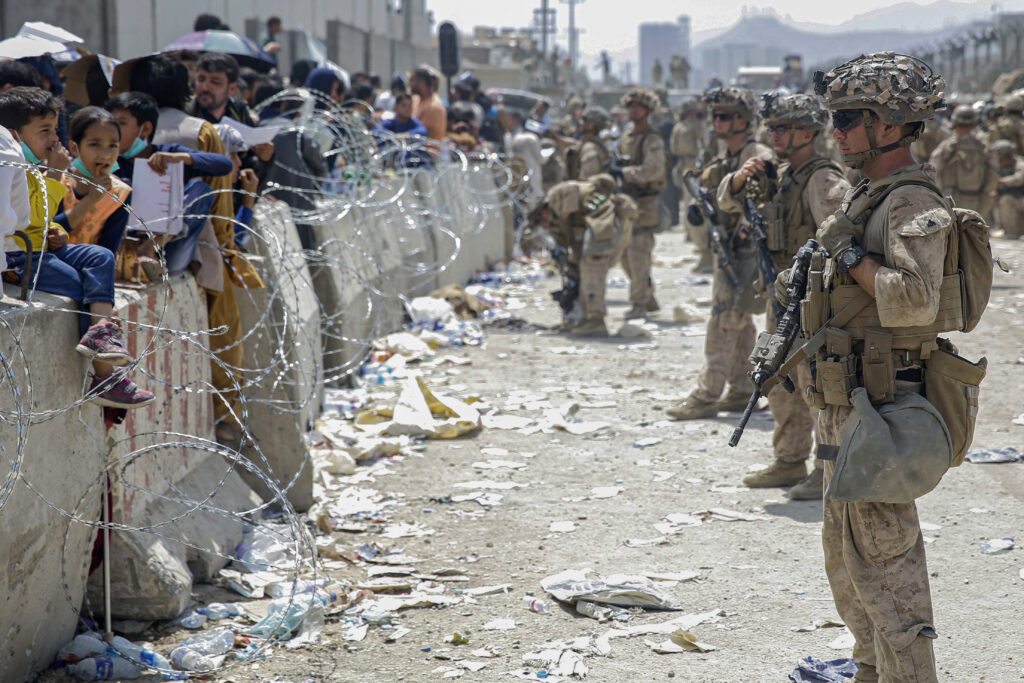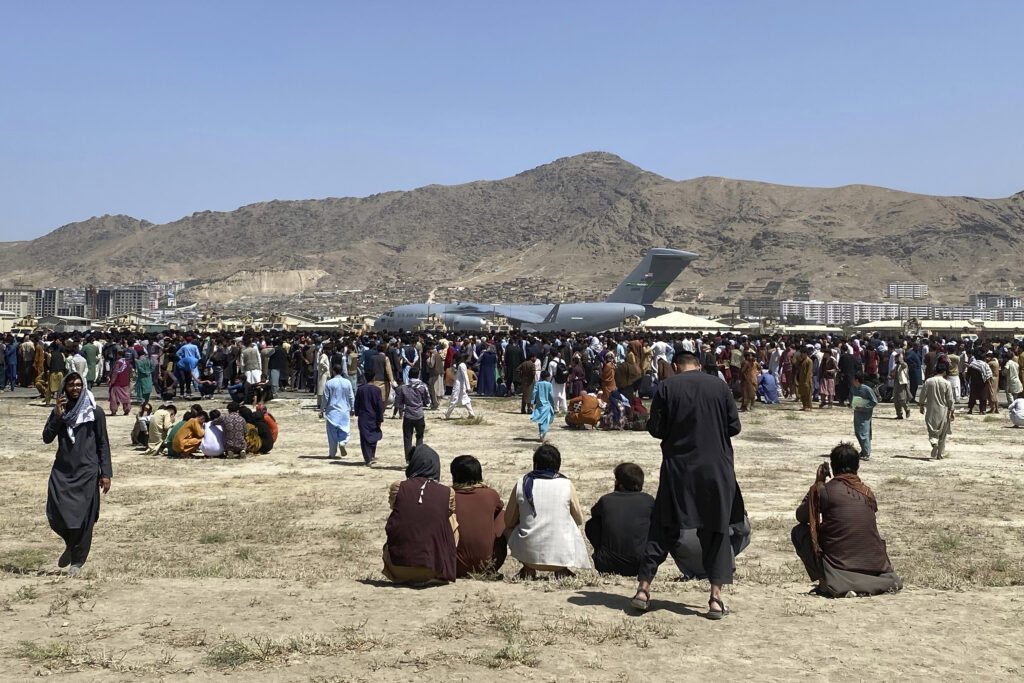When President Joe Biden took office in January 2021, one of the most pressing decisions facing him was what to do about his predecessor’s plan to pull all U.S. troops out of Afghanistan.
As different as Biden was from former President Donald Trump, they both shared an intense desire to bring an end to the 20-year war that had no end in sight and cost the lives of more than 2,400 American troops.
A month before the 2020 election, Trump tweeted, “We should have the small remaining number of our BRAVE Men and Women serving in Afghanistan home by Christmas!”
And one week after Trump lost, over the objections of his defense secretary who he fired, he desperately tried to order all the troops home before he left office in January.

“I was handed a piece of paper with the president’s signature on it which had two sentences,” retired Gen. Mark Milley, former chairman of the Joint Chiefs of Staff, recalled in testimony before the House Foreign Affairs Committee on March 19. “One was withdraw forces from Somalia by the 15th of December and then withdraw all forces out of Afghanistan by the 15th of January,” just five days before Biden took office.
Milley confronted national security adviser Robert O’Brien at the White House, who, along with other national security staff, convinced Trump the complicated retrograde of the remaining 4,500 U.S. troops was logistically impossible and would result in a catastrophic disaster for which he would be blamed.
Only then did the lame-duck president relent and allow 2,500 U.S. troops to remain.
At the Pentagon, where the consensus favored keeping a small number of troops in Afghanistan, along with NATO partners and thousands of civilian contractors to prop up the Afghan government, there was a collective sigh of relief.
When Biden took office, he was faced with what to do about the February 2020 withdrawal deal the Trump administration had signed with the Taliban, which came to be known as the Doha agreement and which called for all U.S. forces to be out by May.
That would mean thousands of NATO troops and the 8,000 or so contractors would have to leave too.
“The NATO slogan at the time was in together, out together,” Milley said. “And the contractors aren’t going to stay unless there’s American military forces to protect them.”
The Taliban were ignoring almost all the conditions it had agreed to — reducing violence, establishing a ceasefire, negotiating a peace deal in good faith — and adhered to only one, not attacking U.S. and coalition troops as they packed up to leave.
“The Taliban benefited from the fact that we were striking them much less frequently and with much less force, particularly after we began some of the programmed drawdowns that were part of the Doha agreement,” retired Marine Gen. Frank McKenzie, the four-star commander of the U.S. Central Command, testified at the House hearing. “They began to become larger, bolder, and more aggressive.”
Meanwhile, the U.S. had already begun to lose the ability to understand the shifting momentum on the battlefield because of the agreed-on reduction of U.S. troop levels from 8,600 to 4,500 during Trump’s last year in office.
“You’re pulling advisers off the so-called Kandaks, the Afghan battalions,” Milley said. “We blinded ourselves. … So we relied on electronic means or technological means in order to be able to see what’s happening with the Afghan security forces. But technology can’t read a person’s heart, they can’t see the negotiation that’s going on locally between the Taliban and the local Afghans.”

What was going on was that the Taliban were demanding surrender agreements from local commanders who felt abandoned by the Doha deal that was negotiated without the participation of the Afghan government and was seen as tantamount to articles of surrender.
The U.S. wasn’t just leaving; it was taking with it the contractors who kept Afghanistan’s fledgling air force flying — the one asymmetric advantage the Afghan government forces had over the Taliban.
“It’s difficult for me to overestimate the negative synergistic pernicious effect drawing down these capabilities had on the Afghan military,” McKenzie testified.
It was against this background Biden had to decide: Did he want to go with Trump’s plan and pull everyone out fast? Did he want to pull everyone out gradually so as not to spark a panic? Or did he want to reverse course and stay?
The nearly unanimous advice Biden got, including from Milley and McKenzie, was to stay, even though it would mean the war would go on.
“But there’s little question in my mind that … if we didn’t withdraw 100%, then we would have been back at war with the Taliban,” said Milley, who nevertheless recommended keeping 2,500 of what he called “high-end Special Forces troops” in Afghanistan in order to buy the time for “a satisfactory negotiated settlement.”
That would require taking a much tougher diplomatic approach to the Taliban, said McKenzie, who had also recommended keeping 2,500 U.S. troops in place.
“We thought it needed to be coupled with an aggressive negotiation program with the Taliban, one that perhaps had a few more sticks and not all carrots,” McKenzie testified.
But Biden, who prided himself on being the lone voice in the White House opposed to President Barack Obama’s 2009 decision to send more troops to Afghanistan, was determined to get out.
Biden, we learned recently, improperly retained a classified handwritten memo he sent Obama at the time laying out his objection to surging more troops into the war zone because it was a point of pride.
“He always believed history would prove him right,” special counsel Robert Hur wrote in his February report.
But Biden wanted more time, and also wanted to keep the U.S. Embassy in Kabul open in the hope that the U.S.-trained and equipped 350,000-strong Afghan army would hold off the Taliban.
So Biden picked what Milley and McKenzie saw as the worst possible option, a drawn-out withdrawal, that made no provisions for evacuating diplomatic staff, American nationals, or Afghan partners.
“It was also our assessment at the time that keeping an embassy open in a war zone, which Afghanistan was, and to do that without the presence of the U.S. military and the contractors and NATO, etc., that that embassy would be untenable,” Milley said.
If you’re leaving, get going, McKenzie advised, and take everyone with you. “From the very beginning, we wanted to get out as quickly as we could because we believe speed brought safety.”
“The fundamental flaw was the timing of the State Department call of the NEO [noncombatant evacuation operation],” Milley said. “That was too slow and too late.”
“Presidents make decisions, and once that decision’s made, we execute,” McKenzie said, but in his first testimony as a civilian, he also delivered a searing rebuke of his former commander in chief.
“On April 11, 2021, I received orders from President Biden, through the secretary of defense, to execute a full military withdrawal by Sept. 11, 2021, a date which was subsequently modified to the end of August. This decision did not include the withdrawal of our embassy, our citizens, and at-risk Afghans,” McKenzie said in his opening statement before the committee.
“It’s important to understand that we had a complete plan to execute that task as well, but were not ordered to do so. The president’s decision was to maintain an embassy, to not require our citizens to leave, and of course, to not expedite the extraction of at-risk Afghans. This was not a military decision.”
McKenzie took personal responsibility for the withdrawal operation in which an attack by a suicide bomber killed 13 American service members and 170 Afghans at the Abbey Gate of Kabul’s Hamid Karzai International Airport, even as he faulted Biden’s decision that he believes resulted in a dangerously chaotic mission.
“It was a tragic event, one of many that have occurred over our 20-year engagement in Afghanistan. It remains my opinion that if there is culpability in this attack, it lies in policy decisions that created the environment of August 2021 in Kabul,” he said.
“The simple fact is this. On the battlefield, even with good planning, tremendous execution by brave people on the ground, the enemy sometimes has success. To ignore this fact is to ignore the fundamental reality of the battlefield.”
The White House was relying to some extent on faulty intelligence assessments that suggested Kabul would not fall for a year or two after foreign troops left.
The Pentagon thought it would be sooner, but nothing indicated August.
The wild card was Afghan President Ashraf Ghani, who, as Milley noted, turned out to be no Volodymyr Zelensky.
“You had Ghani and Zelensky, right? Zelensky stays and his military stays in Kyiv, and you had a nation at war and they’re fighting tooth and nail,” Milley said. “President Ghani and his entire Cabinet, less one, got on airplanes and took off out of their country.”
“As soon as the ANSF [Afghan National Security Forces] saw that, they literally took their uniforms off, put their weapons down, and it collapsed,” Milley said. “I think that was the straw that broke the camel’s back.”
Among the unanswerable questions is what would have happened if the U.S. had stayed, or conversely, had pulled everyone out months earlier.
Would Kabul have fallen sooner? Would more U.S. troops have died? Would a stable peace ever have been achieved?
CLICK HERE TO READ MORE FROM THE WASHINGTON EXAMINER
“We’ll never know,” McKenzie said. “It’s very possible that we could have been fighting the Taliban, but that’s just a counterfactual that we won’t know the answer to.”
“Our assessment was that would keep the Afghan government and the military stable until such time as a diplomatic outcome could occur in accordance with the conditions set in the Doha agreement,” Milley said. “I mean, we’ll never know, I guess, because it didn’t happen.”
